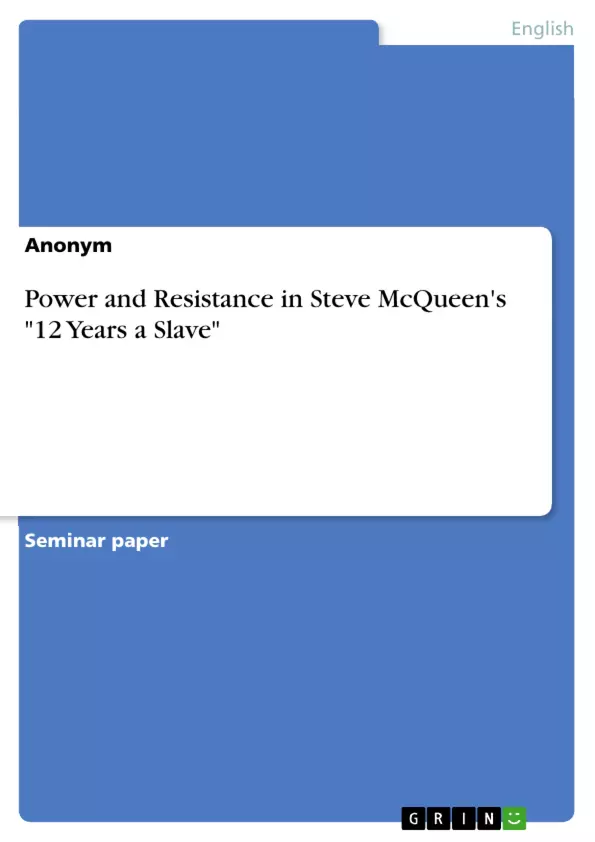The research question of this paper focuses on the relation between power and resistance within McQueen's movie by incorporating Foucault's notion that power is reversible and always brings along resistance.
I argue that power as well as power relations change through practiced forms of resistance. For my analysis of Solomon’s confrontations with white power and strategies of resistance in the movie, I will first illustrate Foucault's theory of power and resistance, followed by a depiction of control and slave resistance in antebellum American slavery. Finally, I will analyse how power and resistance are displayed in the movie.
Although the United States Constitution declares all human beings as equal individuals, white people of European descent regarded themselves as superior compared to people of different ancestry, especially to Blacks. Blacks were not even regarded as human beings and furthermore treated as objects and "legal property" of white people. This derives from the notion of race as an indicating signifier, categorising people based on supposed biological characteristics, including skin colour.
Moreover, race is not a universal concept; rather, it forms “a contingent and unstable cultural category with which people identify". With its prejudicial connotation, the cultural studies concept of race roots in the misbalanced hierarchical power distribution between colonialists and subjected people. Thus, colonialists referred to themselves as 'civilized people', distinguishing from the ‘primitive’ subject and thereby hierarchised human types.
The dominant groups' assumed superiority results in the suppression of the recessive subject by ranking social groups within a hierarchical system of both material and social inferiority and superiority. This leads to the view of race being a cultural instead of a biological phenomenon. Consequently, black people suffered from Whites who maximised their power by inhumane laws and forces as they wanted to restrain and dominate the black mass during antebellum American slavery.
Inhaltsverzeichnis (Table of Contents)
- Introduction
- Foucault
- Power
- Resistance
- Antebellum American slavery
- Control
- Slave resistance
- Analysis: Power and resistance in 12 Years a Slave
- Conclusion
Zielsetzung und Themenschwerpunkte (Objectives and Key Themes)
This paper investigates the interplay of power and resistance in Steve McQueen's film "12 Years a Slave" through the lens of Michel Foucault's theories. The analysis aims to understand how power dynamics shifted and changed through the various forms of resistance employed by Solomon Northup, the protagonist of the film. The study will also delve into the specific historical context of antebellum American slavery to provide context for the film's depiction of power relations.
- The role of power in shaping social structures and individual experiences, particularly in the context of slavery
- The multifaceted nature of resistance and its potential to challenge and transform power dynamics
- The influence of Foucault's theories on understanding power and resistance in historical and contemporary contexts
- The cinematic representation of slavery and its impact on cultural understanding
- The significance of "12 Years a Slave" as a historical drama that explores the complexities of power and resistance.
Zusammenfassung der Kapitel (Chapter Summaries)
- Introduction: The chapter establishes the historical and theoretical context of the paper, highlighting the dehumanization of enslaved Black people and the notion of race as a cultural construct tied to power dynamics. It introduces Solomon Northup's story and Steve McQueen's film as a means of exploring the complexities of power and resistance within the context of antebellum American slavery.
- Foucault: This section provides an overview of Foucault's theories on power and resistance. It highlights Foucault's concept of power as pervasive, multi-faceted, and reversible, as well as the notion that resistance is an inherent part of power relations.
- Antebellum American slavery: This chapter examines the mechanisms of control and forms of resistance employed during the antebellum period. It explores how the system of slavery relied on physical and psychological control, while enslaved people developed various strategies to maintain their humanity and challenge their oppression.
Schlüsselwörter (Keywords)
The key concepts and terms explored in this paper include: power, resistance, slavery, antebellum America, Michel Foucault, 12 Years a Slave, cinematic representation, historical drama, cultural studies, race, social hierarchy, and control.
- Citar trabajo
- Anonym (Autor), 2020, Power and Resistance in Steve McQueen's "12 Years a Slave", Múnich, GRIN Verlag, https://www.grin.com/document/539289



